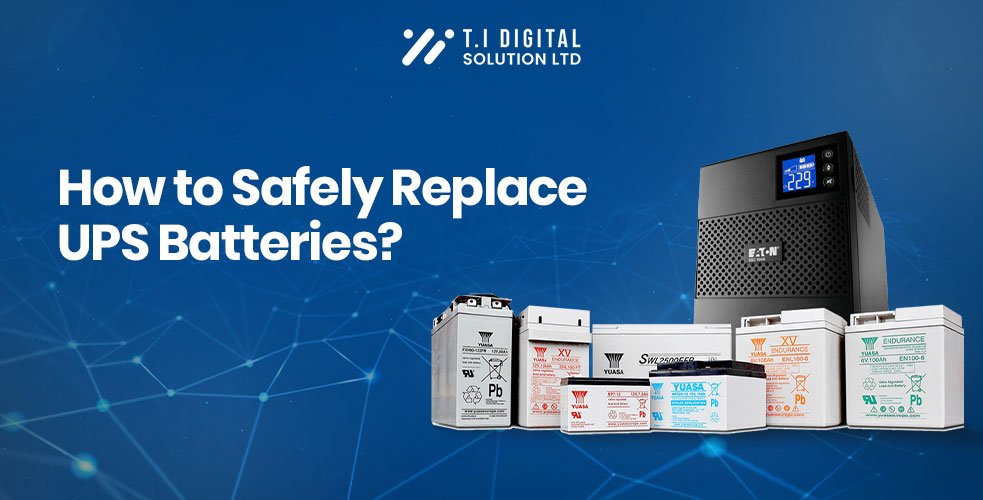A Comprehensive Guide on How to Safely Replace UPS Batteries?

Uninterruptible Power Supply (UPS) systems are essential for safeguarding your electronic devices against unexpected power outages. However, like all batteries, UPS batteries have a limited lifespan and will eventually need to be replaced. If you’re wondering whether you can replace a UPS battery while it’s plugged in or how often you should replace it, this guide has you covered. We’ll walk you through the process of safely replacing your UPS battery and answer some common questions.
Can You Replace a UPS Battery While Plugged In?
The idea of replacing a UPS battery while the unit is still plugged in may seem convenient, but it’s important to exercise caution. The short answer is yes, you can replace a UPS battery while the unit is plugged in, but only if the UPS system is designed to allow hot-swappable battery replacement.
Hot-swappable batteries are designed to be replaced without shutting down the entire UPS system, meaning that your devices will continue to receive power during the battery replacement process. This is particularly beneficial in environments where uptime is critical, such as data centers or offices with sensitive equipment.
However, not all UPS systems support hot-swapping. If your UPS does not have this feature, attempting to replace the battery while plugged in could pose significant risks, including electrical shock or damaging the UPS unit. Always refer to your UPS manual to confirm whether hot-swappable battery replacement is supported.
How Often Should UPS Batteries Be Replaced?
UPS batteries don’t last forever, and their lifespan can vary depending on several factors, including the type of battery, usage patterns, and environmental conditions.
Average Lifespan of UPS Batteries:
- Lead-Acid Batteries: Typically, these batteries last between 3 to 5 years. They are the most common type of battery used in UPS systems.
- Lithium-Ion Batteries: These are newer and can last up to 10 years, though they tend to be more expensive.
Signs That Your UPS Battery Needs Replacing:
- Frequent Beeping: If your UPS starts beeping more frequently, it could be a sign that the battery is failing.
- Reduced Backup Time: If the battery no longer holds a charge for as long as it used to, it might be time for a replacement.
- Physical Damage: Any swelling, leaks, or other visible damage to the battery is a clear indication that it needs to be replaced immediately.
Testing Your UPS Battery:
To ensure your UPS battery is in good condition, it’s advisable to conduct a self-test periodically. Most UPS systems come with a built-in self-test feature that you can initiate from the control panel or via management software. Regular testing will help you monitor the health of your battery and determine when a replacement is necessary.
How to Safely Replace a UPS Battery
Replacing a UPS battery is a straightforward process, but safety should always be your top priority. Follow these steps to ensure a safe and effective replacement:
Step 1: Read the Manual
Before you begin, carefully read the user manual for your specific UPS model. The manual will provide you with detailed instructions and safety warnings specific to your unit.
Step 2: Power Down the UPS (If Necessary)
If your UPS does not support hot-swappable batteries, you will need to power down the UPS and unplug it from the wall outlet. Ensure that all connected devices are shut down and unplugged to avoid any potential data loss or damage.
Step 3: Remove the Old Battery
Locate the battery compartment, which is usually accessible from the front or rear panel of the UPS. Carefully disconnect the old battery by unplugging the connectors. Some UPS systems may require the use of a screwdriver to remove the battery cover.
Step 4: Install the New Battery
Once the old battery is removed, insert the new battery into the compartment and reconnect the connectors. Make sure the connections are secure to avoid any power interruptions.
Step 5: Test the UPS
After installing the new battery, plug the UPS back into the wall outlet and turn it on. Run a self-test to ensure the battery is functioning properly and the UPS is providing backup power as expected.
Additional Tips for Maintaining Your UPS Battery
To extend the life of your UPS battery and ensure it performs optimally, follow these maintenance tips:
- Keep It Cool: High temperatures can significantly reduce the lifespan of your battery. Keep your UPS in a cool, well-ventilated area to avoid overheating.
- Regular Testing: Periodically test your UPS battery to monitor its health and identify any potential issues early on.
- Avoid Overloading: Ensure that your UPS is not overloaded with more devices than it can handle. Overloading can strain the battery and reduce its efficiency.
Replacing a UPS battery may seem daunting, but with the right information and precautions, it can be done safely and efficiently. By following the steps outlined in this guide, you can ensure that your UPS system continues to protect your devices from power interruptions for years to come.
Frequently Asked Questions
Q: What happens if you don’t replace a UPS battery?
A: If you don’t replace a failing UPS battery, it may lose its ability to provide backup power during an outage, potentially leading to data loss or damage to connected devices.
Q: Can a UPS work without a battery?
A: No, a UPS cannot provide backup power without a functioning battery. The battery is essential for storing the energy that powers your devices during an outage.
Q: How do I know if my UPS battery needs replacing?
A: Signs that your UPS battery may need replacing include frequent beeping, reduced backup time, and visible damage to the battery.
